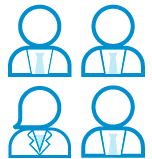
One of the ways to achieve good results in the efforts against drug abuse is the use of drug courts. Drug courts are special court programs with the purpose of achieving a reduction in substance abuse and the increase of the likelihood of a successful rehabilitation program through early and intense treatment, community supervisions, mandatory periodic testing, and other rehabilitation services that a judicial officer supervises (Belenko, DeMatteo, & Patapis, 2002). Evaluation and research have shown that where the implementation of the drug courts is consistent with procedures based on objective studies, they offer a significant reduction in substance abuse, especially among high-risk offenders (Holloway, Bennett, & Farrington, 2006). In addition, they would increase the likelihood of a successful rehabilitation program. In doing this, the courts would reduce the cost of addressing these problems relative to the costs of the criminal justice system.
The drug courts have ten key components that enable them to work efficiently and achieve their goal of stopping drug abuse and other related criminal activity (U.S Department of Justice, 2004). The first component is the integration of drug treatment services with the justice system case processing. The treatment process is usually done in three phases to ensure the efficiency of the component – a stabilization phase, an intensive treatment phase, and a transition phase. The second element is the employment of a non-adversarial technique by prosecution and defense for them to uphold the safety of the public as well as shield the due process and rights of the participants. The third component is the identification of eligible participants early for placement in a drug court program. The procedure is to do an eligibility screening based on the established written criterion, advising the eligible participants about the program requirements and screening of the participants by trained professionals for a most suitable treatment program. The other mechanism is the provision of access to a variety of drugs, alcohol, including other rehabilitation services, repeated drug and alcohol testing to scrutinize self-denial, which is a harmonized tactic to oversee drug courts reactions. Additionally, there is the judicial interaction with the drug courts and participants that consists in the monitoring and evaluation of the achievements of the program goals to gauge its effectiveness. Finally, the remaining components are ensuring a continuous interdisciplinary education to promote effective drug court procedures and generating local support by partnering with public agencies and community-based organizations, thereby enhancing the effectiveness of the drug court programs (Moscher & Akins, 2014).
AI-content Free
On the local level, the operation of drug courts is aimed at diverting offenders with substance abuse problems from incarceration into the treatment programs that have rigorous standards of accountability. Drug courts offer their assistance to the participants, which enables them to recover from addiction and prevents them from engaging in future criminal activities while reducing the costs of processing low-level, non-violent offender cases through national courts, prisons, and jails (Mosher & Akins, 2014). According to Gottfredson, Najaka, and Kearley (2003), drug court participants obtain treatment as well as other services for not less than a period of one year. Court appearances are recurrent with random drug testing with incentives and sanctions to persuade successful compliance and completion of the program. When the participant completes the program, it may result in the dismissal of charges, reduced sentences, or lesser penalties. Reports have shown that drug courts have been effective in reducing drug use and recidivism, maintaining high retention rates in the program and cost-effectiveness (Gottfredson, Najaka, & Kearley, 2003). In addition, some reports term the programs as being able to reunite families, giving birth to drug-free babies, offering greater credibility for the criminal justice process and freeing up criminal justice resources to handle other serious cases (Holloway, Bennett, & Farrington, 2006).
Various resources cover the topic of drug courts, which allows the readers to see how they describe, portray, and represent the courts. Some of these resources include government resources, political resources, newspaper resources, and opinion-based resources. Knowing the way these resources depict drug courts will assist in understanding their importance and the impacts that they have had on peoples lives. In addition, it will assist in knowing ways on how to improve on the programs that the drug courts offer.


Exclusive savings! Save 25% on your ORDER
15% OFF your FIRST ORDER (with the code toppapers15) + 10% OFF every order by receiving 300 words/page instead of 275 words/page
The government resources that cover the topic of drug courts mainly mention the definition of the drug courts while covering the ten key components of the courts. One such resource comes from the Drug Courts Resources Series from the United States Department of Justice titled Defining Drug Courts: The Key Components. The resource describes the ten key components of drug courts while elaborating the purpose and processes of each component. In addition, it lists various organizations that provide information and guidance about matters pertaining to drug courts. Examples of such organizations include Justice Management Institute, National Association of Drug Court Professionals, and State Justice Institute (U.S Department of Justice, 2004). The document portrays drug courts as an important tool in stopping alcohol and drug abuse as well as other related criminal activity.
Another type of resource in consideration is newspaper resources. The topic of drug courts receives a wide coverage in various newspapers. An example of such resource is an article covered by the Daily Herald newspaper about a heroin addict who received a new life as the result of a drug court appearance. Among the people the article titled Drug Courts Give Heroin Addicts a Whole New Life talks about is a 19-year-old former heroin addict said that appearance at the drug court program gave her a whole new life (Cilella, 2015). According to the article, drug courts make the offenders get their life back together by giving them the necessary tools (Cilella, 2015). The drug court the article focuses on is the Kane County drug court. The sentence of the court lasts a minimum of 30 months and has three phases (Cilella, 2015). The first phase concentrates on allowing the participants to focus on their recovery. The second phase allows them to work on rebuilding their lives that they had lost because of their addiction. The third and final phase makes it possible for the participants to plan for their lives after they have finished their drug court programs. The article goes further to mention that drug courts result in reduced prison costs, reduced arrests, and the need for social services (Cilella, 2015).
Original writing according to your instructions
Deadlines from 3 hours to 60 days
All disciplines covered
Confidentiality
24/7 Support
Plagiarism-free papers
Timely delivery
Skilled writers with Master’s/PhD degrees
Personal data security
Instant replies to all your questions
Another newspaper article that covers the topic of drug courts is the article on the stories of drug court graduates by the C & G Newspapers. The article titled Drug Court Graduates Share Stories of Struggle, Hopetalks about the struggles the participants faced before finishing the programs and having their normal lives back (Louwers, 2015). Some of the people who attended the program have been able to improve their lives by getting good jobs, attending support meetings, and managing to stay clean after the program. The articles mainly talk about the 37th District Court program. Among those who completed the program is Carl Brune, 27. The charges against him were possession of heroin and analogs (Louwers, 2015). After spending 18 months in the 37th District Courts program and later 13 months in a recovery house, he was able to get a good job and found the motivation to attend support meetings a few times a week (Louwers, 2015). Another participant, Georgette Aegerter, 28, was able to regain guardianship of her daughter after completing the program (Louwers, 2015). The article positively portrays drug courts as avenues that enable people who previously abused drugs to regain back their lives and have a healthy and productive lifestyle.
The opinion-based resources also cover the topic of drug courts. An example of this type of resource an article by Michael Honda and Martin Sheen (2011) titled Why We Need more Drug Courts. In the article, the authors claim that drug courts should be at the center of the criminal justice reform process (Honda & Sheen, 2011). They give four reasons to support their opinion. First, that drug courts are extremely effective in reducing recidivism. Secondly, those drug courts serve a growing number of military veterans who have charges stemming from substance abuse. Third, drug courts courageously combat drug abuse across various states. Finally, the last reason is that drug courts have been able to offer a reduction in crime by up to 50% (Honda & Sheen, 2011). The authors conclude by saying that if the United States is serious about on lowering criminal justice costs, it should hold the line on drug court funding because the program can return up to $27 for an investment of $1 (Honda & Sheen, 2011). Further, the courts can continue treating addicted offenders and meet the growing needs of the people in the criminal justice system (Honda & Sheen, 2011).
Based on the study of various resources, it is evident that drug courts have been able to provide essential services to non-violent offenders with alcohol and drug use problems. Eligible persons may go to the drug courts instead of justice system case processing. The courts keep individuals in treatment for not less than one year, thus enabling the programs to work. During the period, the participants remain under strict supervision. They participants receive intensive treatment and other services they require; they are accountable for meeting their obligations to the society, courts and family, undergo random and regular drug tests and receive rewards for doing well and sanctions if they do not meet their obligations. The drug courts serve a fraction of the people who have drug addiction problems. Breaking the cycle of drug abuse and its relation to criminal activities needs the establishment of a drug court within the reach of every person.





